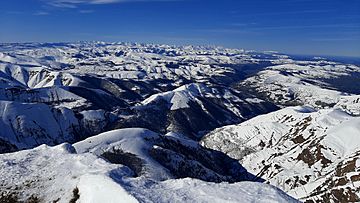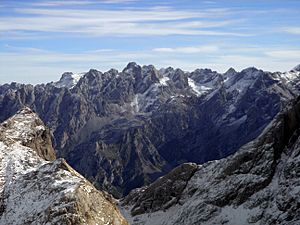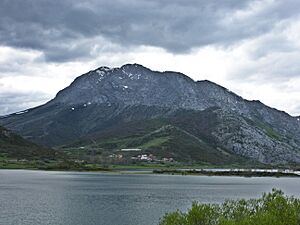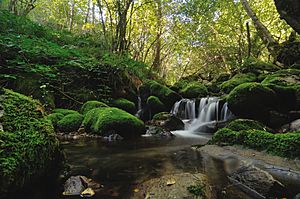Cantabrian Mountains facts for kids
Quick facts for kids Cantabrian Mountains |
|
|---|---|
| Spanish: Cordillera Cantábrica | |

Cantabrian Mountains parallel to the Cantabrian Sea seen from Castro Valnera in an east-west direction. In the background, the Montaña Palentina (left) and the Picos de Europa (right)
|
|
| Highest point | |
| Peak | Torre de Cerredo |
| Elevation | 2,648 m (8,688 ft) |
| Dimensions | |
| Length | 300 km (190 mi) WE |
| Width | 50 km (31 mi) NS |
| Naming | |
| Etymology | Named after the Cantabri |
| Geography | |
| Country | Spain |
| Range coordinates | 43°N 5°W / 43°N 5°W |
| Geology | |
| Age of rock | Carboniferous, Paleozoic, Mesozoic |
| Type of rock | Limestone |
The Cantabrian Mountains (also called the Cantabrian Range) are a major group of mountains in northern Spain. They stretch for over 300 kilometers (180 miles) across northern Spain. They go from the Pyrenees mountains in the east to Galicia in the west, following the coast of the Cantabrian Sea. Their eastern end meets the Sistema Ibérico mountains. These mountains are part of a larger system called the Alpine System.
The Cantabrian Mountains are great for outdoor activities. You can find many trails for hiking and challenging routes for climbing. If you like skiing, there are several ski resorts. These include Alto Campoo, Valgrande-Pajares, Fuentes de Invierno, San Isidro, Leitariegos, and Manzaneda.
Contents
Geography of the Cantabrian Mountains
The Cantabrian Mountains run from east to west, almost parallel to the Cantabrian Sea. They reach as far as the Leitariegos pass. They also extend south between León and Galicia. The western edge of the range is marked by the Minho River valley and the lower Sil River.
The Cantabrian Mountains have many branches and smaller ridges. However, you can usually see two main ranges. One range follows the coast closely. The other, which is taller, forms the northern edge of the large plateau of Castile and León. This taller range is sometimes seen as a continuation of the Pyrenees.
In some places, the coastal range rises steeply from the sea. Everywhere, it slopes so sharply that rivers flowing to the sea are short and fast. The slope from the southern range to the high plateaus of Castile is more gentle. Several large rivers, like the Ebro, start here and flow south or west.
The Cantabrian chain, including all its branches, gets wider from east to west. It goes from about 97 kilometers (60 miles) in the east to about 185 kilometers (115 miles) in the west. Many peaks are over 1,800 meters (6,000 feet) high. The highest points are in the central ridges, near the borders of León, Asturias, Palencia, and Cantabria.
Here you will find the highest peak, Torre de Cerredo, which is 2,648 meters (8,688 feet) tall. Other high peaks include Peña Vieja (2,615 m), Peña Prieta (2,531 m), and Espigüete (2,407 m). Another unnamed peak in the Picos de Europa reaches 2,452 meters (8,045 feet). Further west, peaks like Manpodres, Peña Ubiña, Peña Rubia, and Cuiña are all over 2,100 meters (7,000 feet).
A special feature of these mountains are the "parameras." These are isolated plateaus surrounded by tall mountains or steep rock walls.
The Cantabrian Mountains create a clear boundary between "Green Spain" in the north and the dry central plateau. The northern slopes get a lot of rain from the Cantabrian Sea. The southern slopes are in a rain shadow, meaning they get much less rain.
Main Mountain Ranges
The Cantabrian Range has three distinct parts from west to east:
Western Section
This part includes the Asturian Massif and its foothills. Geologically, it is an eastern extension of the Galician Massif. It has old Paleozoic folds and deep, east-west canyons, like the Cares River valley. The highest point here is Torre de Cerredo at 2,648 meters.
Some ranges in this section are:
- Sierra de la Bobia, with Pico de la Bobia (1,201 m)
- Sierra de Tineo, with Mulleiroso (1,241 m)
- Sierra del Sueve, with Picu Pienzu (1,161 m)
- Sierra de Cuera, with Pico Turbina (1,315 m)
Central Section
The main mountains in this area are the huge Picos de Europa. They are made of Carboniferous limestone and marl. The Paramo de Masa and La Lora grasslands are to the south.
The Picos de Europa are divided into three main parts:
- Cornión Massif in the west, with Torre Santa (2,596 m)
- Urrieles Massif in the center, with Torrecerredo (2,650 m)
- Ándara Massif in the east, with Morra de Lechugales (2,444 m)
Other mountain ranges in Cantabria, located further east, include:
- Fuentes Carrionas Massif, with Peña Prieta (2,536 m)
- Sierra del Escudo de Cabuérniga, a foothill closer to the sea
- Sierra de Peña Sagra, with Peña Sagra (2,046 m)
- Sierra de Peña Labra, with Pico Tres Mares (2,175 m) and Peña Labra (2,006 m)
- Sierra de Híjar, foothills in the high plateau
- Montes de Pas, with Castro Valnera (1,707 m)
Eastern Section
This part includes the Basque Mountains at the eastern end of the system. These mountains have been very eroded and have moderate heights.
Some important ranges here are:
- Inner ranges:
- Coastal ranges:
Plants and Animals
The Cantabrian Mountains are home to many different plants and animals. One important animal is the Cantabrian brown bear (Ursus arctos pyrenaicus). This bear is in danger of extinction. Most of them live in Asturias, but some are also found in Léon, Palencia, and Cantabria. Another rare animal is the Cantabrian capercaillie (T. urogallus cantabricus), a type of large bird.
Other animals living in these mountains include the Iberian wolf (Canis lupus signatus) and the rebeco, or Cantabrian chamois (Rupicapra pyrenaica parva). The forests in the Cantabrian Mountains are mostly made up of beech trees (Fagus sylvatica).
Sadly, the Pyrenean ibex (Capra pyrenaica pyrenaica), a type of wild goat, used to live here but became extinct in 2000.
Protected Areas
The Cantabrian mountain range has several protected areas. One of the most famous is the Picos de Europa National Park. This park, along with others in the Cantabrian region, is part of UNESCO's World Network of Biosphere Reserves. Some of these places are also part of the European Union's Natura 2000 network. This network helps protect wild birds and their habitats.
Some of the protected areas include:
- Picos de Europa National Park
- Muniellos Nature Reserve
- Fuentes del Narcea, Degaña e Ibias Natural Park
- Redes Natural Park
- Somiedo Natural Park
- Protected Landscape Area of Sierra del Sueve
- Fuentes Carrionas and Fuente Cobre-Montaña Palentina Natural Park
- Saja-Besaya Natural Park
- Collados del Asón Natural Park
- Ojo Guareña
Images for kids
-
The Iberian wolf is a subspecies of grey wolf that inhabits the forest and plains of northwestern Spain.
See also
 In Spanish: Cordillera Cantábrica para niños
In Spanish: Cordillera Cantábrica para niños









